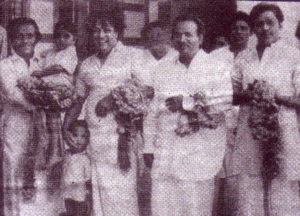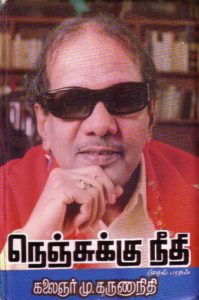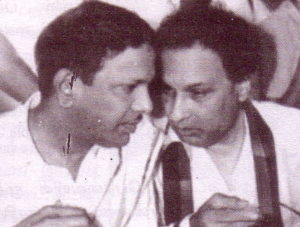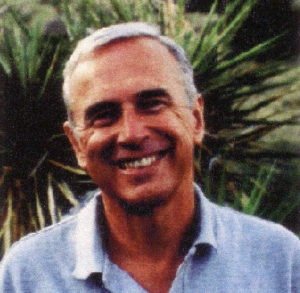Karunanidhi’s Script
by Sachi Sri Kantha, March 29, 2018
Movie Focus on Attention to the Handicapped
Movies per se, when they originated silently, were primarily 100% visual treats. Nevertheless, when silent movies morphed into ‘Talkies’ with the incorporation of the sound element (with dialogues and songs), it became apparent that even visually-handicapped could enjoy them. In the previous chapter, mention was made about MGR’s realization of how his unknown visually-handicapped fans had enjoyed watching his ‘Nadodi Mannan’ movie. It shouldn’t be missed that an opportunity for such a revelation was presented to MGR a decade earlier, when his first hero-role starrer Rajakumari (1947) was released, from a nearby source. This is how, MGR’s then pal and script writer for that movie M. Karunanidhi had presented a scenario of his dying father watching that particular movie, in his autobiography Nenjukku Neethi [Justice to the Heart; hereafter abbreviated as NN].

(Lt-Rt) K.R. Ramasamy, MGR, D.V. Narayanasamy and SSR in 1958, after release from detention
“For nearly 15 days, father was on the brink of death. My mother and I were seated near him. The one who was keen to encourage each step of my life had tears in his eyes. He couldn’t speak well. ‘Have you written the next story?’, he asked. ‘A little more to be done’, I responded. ‘I’m about to finish my story’, he quipped. Even when he was nearing death, his cryptic comment with literary flourish was not lost in him.
Only a month ago, he wished to see the newly released ‘Rajakumari’ for which I’ve written the script. [Note by Sachi: This movie was released in May 1947.] He had lost his eye sight. Even then, he ‘saw’ the movie (at least listened to the dialogues) at a Thiruvaroor theater. He had such great wishes to see me as a budding writer. We couldn’t tolerate watching such a human being lying in deathbed. Nevertheless, the Nature was doing her assigned function. Suddenly his condition worsened. I ran to bring our physician…”
Thus from a nearby source, MGR would have appreciated the value that ‘Talkies’ possessed the merit of entertaining and educating even visually-handicapped folks; and his faith and emphasis in creating and selecting meaningful, heart-rending songs (in collaboration with lyricists, music directors and playback singers) for his movies was partly due to this revelation.
Nenjukku Neethi: An Important Source
A characterization of ‘MGR persona’ will be incomplete if the writings of MGR’s one time pals turned rivals were not taken into consideration. In this regard, MGR’s life was blessed with having two talented artistes, namely M. Karunanidhi (b. 1924) and poet Kannadasan (1927-1981). As both were skilled writers, they had recorded their interactions with MGR in their autobiographical writings. The contra-persona of MGR characterized by Karunanidhi and Kannadasan are documents of some merit in studying MGR’s life. It should also be noted that both Karunanidhi and Kannadasan were not faultless. Simultaneously, Kannadasan himself had been a strong critic of Karunanidhi’s character since mid-1950s. Also to be noted is that Kannadasan was more forthcoming in acknowledging his personal deficiencies than Karunanidhi. Despite these contra-indications, NN volumes of Karunanidhi, remains as an important source for providing contra-persona of MGR.

Karunanidhi’s autobiography Vol. 1 book cover
Both MGR and Karunanidhi serialized their respective autobiographies in early 1970s in Tamil weeklies. While MGR’s autobiography was published in Ananda Vikadan, Karunanidhi’s autobiography was published in Thinamani Kathir, edited by Sa. Visvanathan [pen name Saavi]. As their political friendship had terminated after Karunanidhi’s expulsion of MGR from DMK party in October 1972, MGR’s autobiography came to an abrupt end. MGR became busy in nurturing his DMK offshoot party Anna DMK for the next few years (1973-76) and became the Chief Minister of Tamil Nadu in 1977. Meanwhile, Karunanidhi began writing his autobiography in 1974 and the first volume of NN was published in 1975. As it was written when the MGR – Karunanidhi links were at the nadir, it’s obvious that references to MGR’s deeds in DMK were totally uncomplimentary. Thus, while studying Karunanidhi’s script, one should also focus on vignettes that were omitted other than what were described.
Apart from the similarity in portraying their own lives, both MGR and Karunanidhi did share quite a few similarities in their lives. First, both had experienced poverty until they entered the movie world. Secondly, both had a guiding hand when they entered the movie world. While MGR’s guide was his elder brother actor M.G. Chakrapani, Karunanidhi had his brother in law, actor-musician Chidambaram S. Jayaraman. Thirdly, for both comedian N.S. Krishnan played a vital role as a benefactor in cinema. Fourthly, both lost their young first wives to death, while they were in twenties. Subsequently, both did marry two more times. Fifthly, both supported each other mutually in their ‘rise’ to stardom in Tamil movies; MGR as the hero actor delivering the scripts written by young Karunanidhi.

Karunanidhi and MGR – circa 1960s
This MGR-Karunanidhi collaboration paid splendid harvest to both in Rajakumari (1947), Abimanyu (1948), Marutha Naatu Ilavarasi (1950) and Manthiri Kumari (1950). Subsequently, they also produced a movie (Naam; We, 1953) together under the banner Jupiter-Mekala Pictures, in which MGR played the hero role as a boxer, Karunanidhi writing the script. This movie was not well received by the public. As a result, with others who invested in Mekala Pictures (MGR’s wife V.N. Janaki, villain actor P.S. Veerappa and director A. Kasilingam), MGR left this joint company.
Though MGR – Karunanidhi collaboration did continue for four more movies in 1950s and early 1960s [Malaikallan, 1954; Puthumai Piththan, 1957; Arasilankumari, 1961 and Kanji Thalaivan, 1963], with changing fortunes in politics as well as power play in party politics, jealousy raised its ugly head and the rift between MGR and Karunanidhi came to be widened. Being a strong organizer of party cadres, and having good rapport with elites and commoners, Karunanidhi gained status as one among the handful of deputy leaders of DMK, next in line to succeed Annadurai (Anna). As DMK had invested strongly in Tamil cinema, it’s list of prominent personalities in mid-1950s included N.S. Krishnan, K.R. Ramaswamy, Sivaji Ganesan, D.V. Narayanasamy, Kannadasan, S.S. Rajendran (SSR) and MGR.
Apart from N.S. Krishnan (who was his benefactor) who had died in 1957, Karunanidhi had problems with the other five, other than MGR. Senior actor-singer K.R. Ramaswamy, whose funds sustained DMK in its early years, never had a movie in which Karunanidhi was his script writer. By 1961, Sivaji Ganesan and Kannadasan were forced to leave the DMK via behind the back manipulations by Karunanidhi. The remaining two were movie heroes MGR and SSR, both needed by the party for the funds needed.
In fact, SSR had contested in the 1957 and 1962 Madras State Assembly elections. Though he lost the 1957 election in the Theni constituency by a vote margin of nearly 6,000 votes, in the 1962 election SSR did defeat the Congress Party incumbent of Theni constituency and became one of the 50 elected MLAs of DMK. When the February 1967 Madras State Assembly election came around, SSR was dropped as a DMK candidate! For the first time, MGR stood as a DMK candidate in the newly created St. Thomas Mount (called Parangi Malai in Tamil) constituency.
Madras State Legislative Assembly 1967 Election Results
Robert Hardgrave’s Analysis
As the political cold-war between Karunanidhi and MGR had begun by mid 1960s, Robert Hardgrave, the first non-Indian academic to study DMK politics of 1950s and 1960s, had recorded the following:
“Karunanidhi, allegedly determined to finish MGR, allocated him a predominantly Congress constituency for the 1967 elections with the expectation that he would lose. He hadn’t counted on M.R. Radha.”

Prof. Emeritus Robert Hardgrave, Jr.
Hardgrave had inferred, perhaps rightly, that, “At the time of the shooting incident, MGR’s popularity had been in gradual decline. The shooting, however, brought him to new heights of popularity. In a sense, it gave him new life. From his hospital bed, MGR conducted his campaign for the Madras Legislative Assembly, The day before the election, the Madras papers carried an appeal from MGR to the voters. With a large photograph of the actor in bandages, MGR called upon the people of Tamil Nadu to vote for the DMK. ‘I was to come to your homes, but it could not be done. Now I am asking for your hearts.’ [Dina Thanti, February 14, 1967] In his constituency, he won twice the number of votes polled by his Congress rival.”
Election Constituency 16: St. Thomas Mount
Polling date February 21, 1967. Polled Votes 82, 755; Valid Votes 81,151.
M.G. Ramachandran (DMK party) – 54,106 votes
T.L. Raghupathy (Congress party) – 26,432 votes
vote margin 27,674.
MGR’s Congress Party rival T.L. Raghupathy at this contest was a youthful popular president of the Pallavaram Panchayat Union. Comparatively, Karunanidhi’s performance at the same election was as follows.
Election Constituency 12: Saidapet
Polling date February 21, 1967. Polled Votes 88,961; Valid Votes 87,602.
- Karunanidhi (DMK party) – 53,401 votes
S.G. Vinayagamurthi (Congress party) – 32,919 votes
vote margin 20,482.
Both MGR and Karunanidhi were two among the 137 winning candidates out of 174 who contested under DMK party label. At that election, for the first time DMK and its electoral alliance parties (Swatantra Party lead by C. Rajagopalachari and Communist Party of India) defeated the Congress Party led by K. Kamaraj. Though Congress Party did employ its team of movie personalities such as Sivaji Ganesan, Padmini, K.B. Sundarambal and Kannadasan in canvassing votes, their appeal was blunted by the wounded MGR’s charisma. Among the 232 who contested under the Congress Party label, only 51 were victorious. Performance of the political parties in the 1967 Madras Legislative Assembly elections is presented in the table nearby.
Karunanidhi’s Gripe against MGR
Karunanidhi’s gripe against MGR’s behavior in 1966 need attention too. In his autobiography NN, Karunanidhi had written,
“The Tiruchi-Thanjavoor regional Conference of DMK was held on June 14-15, 1966 under Professor K. Anbazhagan’s presidency…The bad deed of one individual had bounded my legs in not attending that conference. S.S. Rajendran (SSR) was contesting the president’s election for the South Indian Actor’s Federation. ‘Kaka’ Radhakrishnan was the candidate of the opposing party. Anyone belonging to the Kazhagam (i.e., DMK) should support the candidacy of SSR? Isn’t that the expected formality? But, one of the ‘prominent personalities’ of Kazhagam acted against the defeat of Kazhagam-supported candidate? He did underhand work; spent money, used cars and influence to defeat SSR.
Had he participated in the campaigns of Kazhagam? Or gone to jail? Did he receive any wounds in his body? Was his life threatened? Without any sacrificial ‘badges’ to his name, he had reached the front rank. His only badge of merit was that when thousands of Kazhagam activists participated in the 1965 campaign [i.e., anti-Hindi agitation] not caring for their lives and shed blood, he was acting in love scenes at Goa beach!
This ‘special individual’ Mr. M.G. Ramachandran did work to defeat SSR in that election. My heart was deeply troubled by his insincere deeds…Nevertheless, SSR got elected. I was so upset by MGR’s deeds and came to hate him. I complained to Anna, whether his actions shouldn’t be critiqued strongly. As SSR had got elected, so as not to exaggerate such violations, Anna had kept silent. Nevertheless, MGR’s deeds irritated me, and I opted not to participate in the functions where MGR participated. That’s why I was in Chennai, when the Tiruchi-Tanjavoor regional conference was held.”
As one would expect, petty mindedly, Karunanidhi had completely omitted any mention of M.R. Radha – MGR shooting incident of January 1967 in NN, as if both Radha and MGR were strangers to him. In fact, it was Radha who adorned Karunanidhi with the popular tag ‘Kalaignar ‘ (the Artist) for scripting the stage drama ‘Thooku Medai’ [Hanging Platform] for Radha’s troupe in late 1940s. While almost all the political analysts in Tamil Nadu and elsewhere were certain that this particular shooting incident in January prior to the elections was a contributory factor for a large proportion of sympathy votes to MGR and in turn to DMK alliance, Karunanidhi was not so magnanimous then. Rather, he had described how he was lucky to escape from a pre-election violent incident that threatened his own life. Only when volume 5 of NN was published in 2013, Karunanidhi made amends, in writing positively about his personal links to MGR and his wife V.N. Janaki. This was 26 years after MGR’s death and 17 years after Janaki’s death.
SSR’s Description of Detention in Prison
As an antidote to Karunanidhi’s petty-mindedness, one can depend on SSR’s description of MGR’s contribution to the DMK funds. SSR had recorded that both he and MGR shared jail space, when both were arrested and detained in January 1958, as a precautionary act against the protest to the then Prime Minister Nehru’s visit to Madras. Excerpts from SSR’s autobiography are as follows:
“In those days [the party] didn’t have much funds. When such situations arose, annan MGR and I took major share for the deeds. There were sewing machines owned by MGR Pictures and SSR Pictures. Producing black flags for demonstration was carried out there night and day…
We were held in the First Class section of the Central Jail. Though in name it was ‘First class’, in that small room there was an elevated plank with bug infested bed mattress. We couldn’t use it at all, and we slept in the floor using our hands as pillows. The next day, we were served rice in a round aluminum plate. While I ate that with difficulty, I looked at MGR. He was eating that food without any concern, and told ‘In my young days, I had eaten food like this. As such, this experience is not new for me.’ They had also kept a mud pot with a tin can for drinking water. Next to that, there were two more mud pots. I asked, ‘Why these are here?’ He replied, ‘Those are for toilet needs’. I was somewhat restless; ‘Anne, how can we use these?’ He comforted me by saying, ‘What’s the alternative? Think about other prisoners who are held 5 or 6 in a similar room like this’. He also told that previous day when he was brought to the police station, he had received such information from the jailers. I’d say that his strength depends on precautionary actions and reacting accordingly to the unexpected events.
After hearing that we two were placed in detention, many film producers and technicians visited us. They also brought as fruit gifts in many bags and bundles. We shared this with fellow party activists and other prisoners. Those who were serving death sentence and life imprisonment had been there since M.K. Thyagarajah Bhagavathar and N.S. Krishnan were held there [Note by Sachi: This was in 1945.]. As such, these prisoners couldn’t recognize neither MGR nor me. Then, MGR told me: ‘We should take note of the prison conditions seriously. Until now, we had depicted prison situation in cinema in somewhat comfortable settings. Hereafter, in our movies, we have to show it realistically. Then only, average folks will comprehend the plight of such degradation.’
It is true that in the first decade of DMK party’s history, quite a number of its front ranking members including Anna, Karunanidhi and Kannadasan did spend longer time in prison detention, in comparison to movie heroes like MGR and SSR. This was the period (1952 – 1963) when Rajagopalachari and Kamaraj were the chief ministers. It could also be inferred that Kamaraj, being a shrewd politician sensitive to the pulse of commoners, never felt comfortable to detain movie heroes for minor infractions in prison to earn displeasure of the society at large. Simultaneously, Anna himself, depended on the funds generated by the ‘golden geese’ [movie stars, K.R. Ramasamy (until mid-1950s) as well as MGR and SSR (since 1956)] to the party and hesitated to tax them beyond limits. Karunanidhi’s financial contribution to the party was rather limited. If so, he would have bragged about it. This explains the jealousy Karunanidhi and some of his then party colleagues (not affiliated with the movie industry) had against MGR.
As per why he didn’t stand in the Feb. 1967 election representing DMK (though being a sitting MLA), SSR had written, “as MGR had become a recuperating patient at the hospital, his own responsibilities in election fund collections increased tremendously, and he also had to canvas votes for other party candidates in other constituencies, he was reluctant to be a candidate himself. Anna also accepted this.” This could be so. But, by the time MGR was shot in January 12, 1967, candidate selection for the party would have been finalized and like what Karunanidhi did to MGR in the selection of constituency, SSR might have found that his rank in the party was also compromised and he felt setting himself aside was a face saving explanation.
Poet Kannadasan’s Version of the 1967 Election
Kannadasan had presented the anti-DMK version of the 1967 election results in his autobiography. As it makes interesting reading, I provide excerpts below. Make note that Kannadasan refers himself in third person singular.
“Wherever he went, he saw meeting crowds bigger, he believed that Congress Party’s victory in the 1967 elections is certain, and DMK may win plus 20 seats than previous time – at most 70 seats. On that election, all his calculations turned false. At the propaganda meeting stages, he danced the worse. They say, ‘ghost-ridden guy will dance faster than the ghost’. He did dance faster like that.
When they looked, they felt that had more speakers and writers than DMK. Even Kamaraj had such an illusion. That’s why, he himself claimed, ‘I shall win by sleeping.’ 1967 was a big testing year for Tamil Thesiyam [Tamil Nationalism] movement. Was it a premonition that the plane that carried Kamaraj caught fire, that he had a car accident and had knee injury and prior to that his house was set on fire in Delhi?
During the general election, many Congress folks earned a lot. What he did was to spent money and publish a felicitation volume. Even Congress guys didn’t buy that. Sivakasi Aiyah Nadar asked for 200 copies of the volume, and he returned all that. He was after all, the big guy who was closest to Kamaraj. Met Kamaraj, before the vote counting day. He was listening to the police reports of exit vote analysis. He said, ‘Congress will win 140 seats for sure.’
On the day when results were announced, he had taken a bath and was at the house of Mettupalayam Rayappa Gounder’s, adjacent to actress Padmini’s house. He was seated with a bottle of beer, a bottle of whiskey and two telephones. First result was announced at 11 am. Anandanayagi lost! [Note by Sachi: T.N. Anandanayaki was a prominent Congress Party minister then.] With time drifting towards 3 pm and 4 pm, losses accumulated and he was shaken. Nothing gave him optimism. At night, only his driver Babu Ro and he remained. He went to sleep, only after learning that ‘DMK had definitely won.’ When he guessed, ‘Will this guy be a minister? Will that guy be a minister?’ he felt being stabbed by some…
What was worse – Kamaraj had lost. That also in Virudhunagar! He visited Kamaraj’s house. Many were consoling themselves by mentioning that even Annadurai had lost in 1962. Many were crying. Kamaraj was lying in bed, due to the car accident he had. He felt like setting fire to Virudhunagar itself. He was even tempted to sing a ‘curse’…
After the loss of Congress Party, for two to three days, he moved like a lunatic. He couldn’t convince himself with DMK’s win. Anna was a good and respectable guy. In some sense, he was even greater than Kamaraj. But, DMK party was God’s curse to Tamil civilization. DMK’s growth was based on ridiculing the traditions, temples, and well respected traits among innocent folks. It never trusted the goodwill and trust.”
What Kannadasan had written about his estimate of crowds assembled at the election meeting, Kamaraj’s guess and exit vote analysis was not wrong altogether. Even Anna was surprised by the margin of election results that propelled DMK to power in 1967. Thus, it gives credence to the assertion that MGR’s gun wound injury, and how DMK brains exploited this to harvest sympathy votes was a significant factor contributing to DMK’s win.
Cited Sources
Robert L. Hardgrave Jr.: When Stars displace the Gods: The folk culture of cinema in Tamil Nadu, In: Essays in the Political Sociology of South India, Usha Publishers, New Delhi, 1979, pp. 92-124. (Originally appeared as, Occasional Papers No.3, Center for Asian Studies, University of Texas at Austin, 1975).
Kavignar Kannadasan: Manavaasam (autobiography), vol. 2, Vanathi Pathippagam, Chennai, 5th ed., 1991 (orig.published 1988), pp. 134-138.
- Karunanidhi: Nenjukku Neethi, (autobiography), vol.1, Thirumagal Nilayam, Chennai, 2nd ed., 1985. 755 pp.
- Karunanidhi: Nenjukku Neethi (autobiography) vol. 5, Thirumagal Nilayam, Chennai, 2013, pp. 182-184.
S.S. Rajendran: Naan Vantha Pathai (autobiography), Akani Veliyeedu, Vandavasi, 2014.
It is amazing to read the way Dr. Sachi have juxtaposed the different versions of the events around 1967 election by different key players, but the words of the grand poet Kannadasan came to be true, “DMK party was God’s curse to Tamil civilization”, the party was hijacked by Karunanidhi and became his family property, every curse that befell on the Tamils including the Mullivaikkal genocide can be attributed to Karunanidhi.